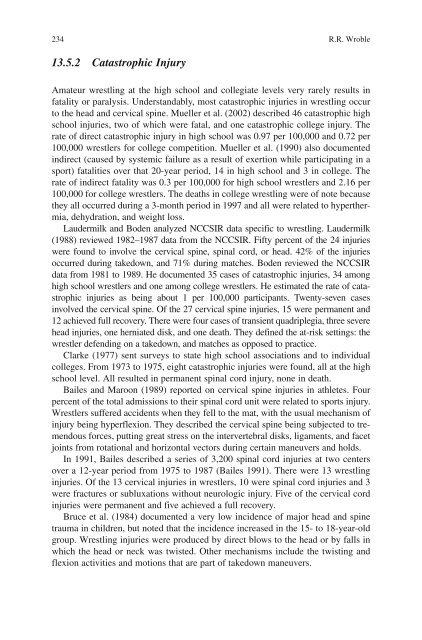Nutrition in Combat Sports
Nutrition in Combat Sports
Nutrition in Combat Sports
Create successful ePaper yourself
Turn your PDF publications into a flip-book with our unique Google optimized e-Paper software.
234 R.R. Wroble<br />
13.5.2 Catastrophic Injury<br />
Amateur wrestl<strong>in</strong>g at the high school and collegiate levels very rarely results <strong>in</strong><br />
fatality or paralysis. Understandably, most catastrophic <strong>in</strong>juries <strong>in</strong> wrestl<strong>in</strong>g occur<br />
to the head and cervical sp<strong>in</strong>e. Mueller et al. (2002) described 46 catastrophic high<br />
school <strong>in</strong>juries, two of which were fatal, and one catastrophic college <strong>in</strong>jury. The<br />
rate of direct catastrophic <strong>in</strong>jury <strong>in</strong> high school was 0.97 per 100,000 and 0.72 per<br />
100,000 wrestlers for college competition. Mueller et al. (1990) also documented<br />
<strong>in</strong>direct (caused by systemic failure as a result of exertion while participat<strong>in</strong>g <strong>in</strong> a<br />
sport) fatalities over that 20-year period, 14 <strong>in</strong> high school and 3 <strong>in</strong> college. The<br />
rate of <strong>in</strong>direct fatality was 0.3 per 100,000 for high school wrestlers and 2.16 per<br />
100,000 for college wrestlers. The deaths <strong>in</strong> college wrestl<strong>in</strong>g were of note because<br />
they all occurred dur<strong>in</strong>g a 3-month period <strong>in</strong> 1997 and all were related to hyperthermia,<br />
dehydration, and weight loss.<br />
Laudermilk and Boden analyzed NCCSIR data specific to wrestl<strong>in</strong>g. Laudermilk<br />
(1988) reviewed 1982–1987 data from the NCCSIR. Fifty percent of the 24 <strong>in</strong>juries<br />
were found to <strong>in</strong>volve the cervical sp<strong>in</strong>e, sp<strong>in</strong>al cord, or head. 42% of the <strong>in</strong>juries<br />
occurred dur<strong>in</strong>g takedown, and 71% dur<strong>in</strong>g matches. Boden reviewed the NCCSIR<br />
data from 1981 to 1989. He documented 35 cases of catastrophic <strong>in</strong>juries, 34 among<br />
high school wrestlers and one among college wrestlers. He estimated the rate of catastrophic<br />
<strong>in</strong>juries as be<strong>in</strong>g about 1 per 100,000 participants. Twenty-seven cases<br />
<strong>in</strong>volved the cervical sp<strong>in</strong>e. Of the 27 cervical sp<strong>in</strong>e <strong>in</strong>juries, 15 were permanent and<br />
12 achieved full recovery. There were four cases of transient quadriplegia, three severe<br />
head <strong>in</strong>juries, one herniated disk, and one death. They def<strong>in</strong>ed the at-risk sett<strong>in</strong>gs: the<br />
wrestler defend<strong>in</strong>g on a takedown, and matches as opposed to practice.<br />
Clarke (1977 ) sent surveys to state high school associations and to <strong>in</strong>dividual<br />
colleges. From 1973 to 1975, eight catastrophic <strong>in</strong>juries were found, all at the high<br />
school level. All resulted <strong>in</strong> permanent sp<strong>in</strong>al cord <strong>in</strong>jury, none <strong>in</strong> death.<br />
Bailes and Maroon (1989) reported on cervical sp<strong>in</strong>e <strong>in</strong>juries <strong>in</strong> athletes. Four<br />
percent of the total admissions to their sp<strong>in</strong>al cord unit were related to sports <strong>in</strong>jury.<br />
Wrestlers suffered accidents when they fell to the mat, with the usual mechanism of<br />
<strong>in</strong>jury be<strong>in</strong>g hyperflexion. They described the cervical sp<strong>in</strong>e be<strong>in</strong>g subjected to tremendous<br />
forces, putt<strong>in</strong>g great stress on the <strong>in</strong>tervertebral disks, ligaments, and facet<br />
jo<strong>in</strong>ts from rotational and horizontal vectors dur<strong>in</strong>g certa<strong>in</strong> maneuvers and holds.<br />
In 1991, Bailes described a series of 3,200 sp<strong>in</strong>al cord <strong>in</strong>juries at two centers<br />
over a 12-year period from 1975 to 1987 (Bailes 1991). There were 13 wrestl<strong>in</strong>g<br />
<strong>in</strong>juries. Of the 13 cervical <strong>in</strong>juries <strong>in</strong> wrestlers, 10 were sp<strong>in</strong>al cord <strong>in</strong>juries and 3<br />
were fractures or subluxations without neurologic <strong>in</strong>jury. Five of the cervical cord<br />
<strong>in</strong>juries were permanent and five achieved a full recovery.<br />
Bruce et al. (1984) documented a very low <strong>in</strong>cidence of major head and sp<strong>in</strong>e<br />
trauma <strong>in</strong> children, but noted that the <strong>in</strong>cidence <strong>in</strong>creased <strong>in</strong> the 15- to 18-year-old<br />
group. Wrestl<strong>in</strong>g <strong>in</strong>juries were produced by direct blows to the head or by falls <strong>in</strong><br />
which the head or neck was twisted. Other mechanisms <strong>in</strong>clude the twist<strong>in</strong>g and<br />
flexion activities and motions that are part of takedown maneuvers.

















